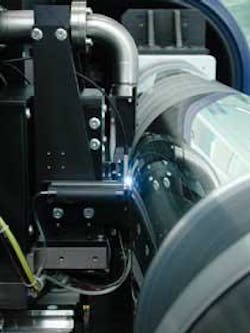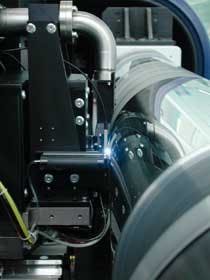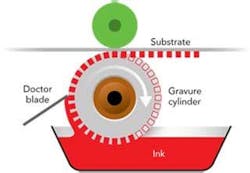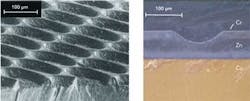Laser microstructuring of gravure print forms
by Guido Hening, Karl-Heinz Selbmann, and Stefan Brüning
Direct laser microstructuring offers improved precision, repeatability, flexibility, and productivity
In industrial gravure print form fabrication large surface areas are structured with high spatial resolutions. The fast workflow cycles of the print rollers require an efficient engraving of some square meters with microprecision in a short time. Application of lasers in this field enables the following: high machining rates, fine focusing, and the advantages of digital modulation. The traditional ways of gravure print form imaging such as mechanical engraving with a diamond stylus or chemical etching are currently being replaced by direct laser microstructuring due to improved precision, repeatability, flexibility, and productivity.
A rotary gravure print form consists of a steel cylinder electroplated with a homogeneous and even surface layer of copper or zinc. The image information is represented by microscopically small cell volumes that are engraved into the copper or zinc surface and that transfer the printing ink into the substrate (see FIGURE 1). A thin chromium layer ensures a long lifetime under strongly abrasive conditions in the printing press. By using a doctor blade, only the amount of ink defined by the cell size will be transferred.
Gravure cylinders cover a range of 0.3–4.4m in length with a circumference of 0.3–2.2m and a surface area of up to 10m2. With screen resolutions of 60–400 l/cm the typical number of cells on a cylinder is about 108 to 1010. High pulse repetition rates and high average power lasers are required to manage the imaging process in an economically acceptable time.
The most efficient method for large-scale microengraving by thermo-optical ablation is the “one shot—one cell” method: a pulsed laser beam creates a complete cell with each single laser pulse. A Q-switched Nd:YAG laser system (see FIGURE 3) with 500W average power at the working focus and repetition rates up to 70kHz enables volume ablation rates of the zinc up to 1cm3/min and an area rate up to 0.1m2/min. The cell shape is defined by the intensity profile of the laser beam.
Half-autotypical cells (depth and diameter variable over the gray scale) can be generated using a Gaussian beam profile and conventional cells (depth-variable with constant diameter for each gray value) using a top hat profile (see FIGURE 2). The cell volume depends on the pulse energy, which is controlled by the digital image data and set with an acousto-optical modulator. Diameters range from 25m to 150m defining the screen resolution of the image, and depths from 1m to 40m defining the gray values of the printed dots.
Heat conduction and convection of molten material must be reduced to a minimum. For this purpose, a special electro-plated Zn material with organic additives has been developed by Daetwyler with lower heat conductivity than normal zinc structures. This zinc can be ablated mainly by evaporation, and the melting area and burrs can be reduced to a thin deposit of less than 2–3m around the cell.
The entire cylinder surface is engraved in rotation by writing one single continuous helical track of cells. While the cylinder rotates with up to 20 revolutions/s, the processing head moves parallel to the axis of the cylinder with a cross feed of 15–150µm/revolution (depending on the screen resolution). The thickness of the walls is only 4–6µm between the cells at maximum tone value. This requires a beam pointing accuracy on the cylinder of about 1µm.
Another option is the pulsed high-power fiber laser (500W average power), with a pulse repetition rate tunable from 30 to 100kHz. This system permits “one shot” drilling of large cells (e.g. 140µm diameter for a 70 l/cm screen) at 35kHz where more energy per pulse is available. Smaller cells (e.g. 25µm diameter for a 400 l/cm screen), needing less pulse energy, can be engraved at 100kHz. This repetition rate flexibility improves the production efficiency of high-resolution screens.
The laser beam operates as a non-contact tool, a crucial advantage compared to electromechanical gravure with the diamond stylus. Uniformity of the gravure is assured over the entire width of the cylinder providing predictability and repeatability for the printing process. Because of the high repetition rate the one shot—one cell laser process is about 10 times faster than the electromechanical gravure.
Beam intensity profile modulation
In the printing market many different substrate materials (such as paper or flexible foils) are available, each with individual surface properties. The way to optimize the ink transfer depends on the surface of the substrate (e.g. roughness, ink absorptive capacity), ink parameters like viscosity or size of pigments, and the print form. The optimization can be matched for each individual case by using different shapes of the gravure cells.
Apart from heat conduction and convection processes the cell represents an exact copy of the intensity profile of the laser pulse at the focal point. To get a specifically defined shape for each individual cell, the spatial intensity profile of the beam is formed actively and in real time at rates up to 100kHz and controlled by the image data. The general scheme of this spatial modulation technique is shown in FIGURE 4.1
Shape, diameter, and depth can be assigned independently for each single cell by active modulation of the intensity profile and independent variation of the energy of each laser pulse. This new cell type in print form fabrication is named super halfautotypical cell (SHC) as it represents an extension of the halfautotypical cell properties (their depth and diameter are variable, but not independently controllable).
The SHC modulation permits engraving all kinds of cell types (conventional, autotypical, halfautotypical) with one laser system. Formerly, different processes (electromechanical engraving, chemical etching) were needed. It is now possible to generate completely new cell configurations that optimize the ink transfer characteristic and the printability for each individual color %-tone value and for each print substrate.
Strategies and applications
Apart from the one shot—one cell method with SHC beam profile modulation, gravure cells can also be designed by superimposing consecutive laser pulses, where the individual spot sizes are smaller than the respective size of the required cell (e.g. a 10–15µm spot size and 100µm cell size). The resulting cell has a shape and internal structure dependent on the modulation, overlapping, and scan scheme of the laser pulses (i.e. an imagesetter scan algorithm).
A CW operating laser is on/off- or grayscale-modulated and engraves small overlapping stripes which together form a rhombic cell. An advantage is the high resolution of the image (i.e. 1000 l/cm for 10µm feed forward steps and a laser spot size of 15–20 µm). A disadvantage, the loss of productivity, is compensated by higher modulation frequencies (about 1MHz) and the use of multibeam engraving heads.
High brightness fiber lasers (200–600W, CW and pulsed) or ultrashort-pulse lasers allow for this advanced approach of engraving because of their high peak power at the focus. Apart from zinc, the high brightness also allows the engraving of other materials such as copper or ceramics.
The imagesetter scan process algorithm is applicable to numerous high resolution 2D (printing) and 3D (embossing) applications. An example is engrave gravure roller for RFIDs.
Printed electronics is an upcoming new technology in which the required high precision of electronic components and circuits define new benchmarks for accuracy and homogeneity of the printouts. The conducting and semiconducting organic or inorganic inks are mostly paste-like and difficult to print. Precise control of cell geometry and surface texture of the gravure print form is essential for homogeneous, pinhole-free layers of these functional inks. FIGURE 5c shows test engravings for RFID antennas. The outline has a broadness of only 10µm.
Summary and outlook
Laser technology—combined with digital imaging methods—has improved the traditional processes of print form fabrication regarding efficiency, range of screens, precision, and quality of the printout. Different laser types can be utilized by applying appropriate production algorithms. Today, the one shot—one cell SHC process with modulated laser beam profiles is the fastest process for gravure and can be matched to different substrate, ink, and printing conditions. New engraving algorithms with high-power TEM00 sources enable the extension of laser ablation methods to a wider spectrum of industrial applications like Anilox rollers for large area material transfer, high precision gravure patterns for printed electronics, or for three-dimensional embossing tools. Ultrashort-pulse lasers will push and improve these methods if the required laser power can be achieved and new appropriate engraving algorithms for multi-shot processing developed. The challenge for the future is to optimize the ablation process with picosecond-ultrashort-pulse lasers.
References
1. Hennig, Selbmann, Brüning et al., “Laser Precision Micro Fabrication in the Printing Industry,” JLMN Vol. 1.2, 89–98 (2006).
Guido Hennig and Karl-Heinz Selbmann are with MDC Max Daetwyler AG, Switzerland, and Stefan Brüning is with Schepers GmbH, Germany.






